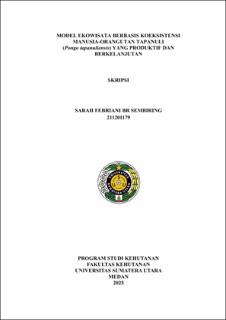| dc.description.abstract | Orangutan habitat, especially in other use areas (APL), has been a source of livelihood and processed land for generations. Orangutans forage and nest on community lands that are considered harmful by the community. One of the orangutan species on the island of Sumatra is the Tapanuli Orangutan. Economic activities that can be developed as an effort to utilize the economic potential of natural resources in the form of the existence of animals while maintaining their sustainability is ecotourism. This study aims to identify the potential for ecotourism around the habitat of the Tapanuli Orangutan and examine the ecotourism model based on the coexistence of Tapanuli Orangutans. Using descriptive observation methods, interviews, and transparency studies, this research identified ecotourism potential. The results showed that there are 16 points of ecotourism potential in Bulu Mario Village, which are divided into four main categories, namely animal observation,camping area, rice fields, water and rivers. Ecotourism based on human-Orangutan coexistence is not new. Many ecotourism model practices have been developed in the habitat of the Sumatran Orangutan and Bornean Orangutan but not yet in the habitat of the Tapanuli Orangutan. The results of the research provide an understanding to the community about the potential of ecotourism around and ecotourism models that can be applied in Bulu Mario Village, South Tapanuli Regency. | en_US |


